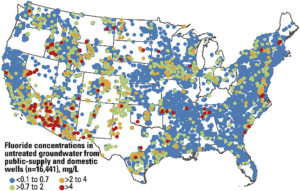Abstract
Highlights
-
- Data from 38,105 wells used to characterize F occurrence in U.S. groundwater.
- 85–87% of F concentrations are below the 0.7 mg/L oral-health benchmark.
- Multiple factors control F concentrations in groundwater.
- Three case studies illustrate processes that produce elevated F concentrations.
- ~28,200,000 people potentially served by domestic wells with F < 0.7 mg/L.
Data from 38,105 wells were used to characterize fluoride (F) occurrence in untreated United States (U.S.) groundwater. For domestic wells (n = 11,032), water from which is generally not purposely fluoridated or monitored for quality, 10.9% of the samples have F concentrations >0.7 mg/L (U.S. Public Health Service recommended optimal F concentration in drinking water for preventing tooth decay) (87% are <0.7 mg/L); 2.6% have F > 2 mg/L (EPA Secondary Maximum Contaminant Level, SMCL); and 0.6% have F > 4 mg/L (EPA MCL). The data indicate the biggest concern with F in domestic wells at the national scale could be one of under consumption of F with respect to the oral-health benchmark (0.7 mg/L). Elevated F concentrations relative to the SMCL and MCL are regionally important, particularly in the western U.S. Statistical comparisons of potentially important controlling factors in four F-concentration categories (<0.1-0.7 mg/L; >0.7-2 mg/L; >2-4 mg/L; >4 mg/L) at the national scale indicate the highest F-concentration category is associated with groundwater that has significantly greater pH values, TDS and alkalinity concentrations, and well depths, and lower Ca/Na ratios and mean annual precipitation, than the lowest F-concentration category. The relative importance of the controlling factors appears to be regionally variable. Three case studies illustrate the spatial variability in controlling factors using groundwater-age (groundwater residence time), water-isotope (evaporative concentration), and water-temperature (geothermal processes) data. Populations potentially served by domestic wells with F concentrations <0.7, >0.7, >2, and >4 mg/L are estimated to be ~28,200,000, ~3,110,000; ~522,000; and ~172,000 people, respectively, in 40 principal aquifers with at least 25 F analyses per aquifer.

